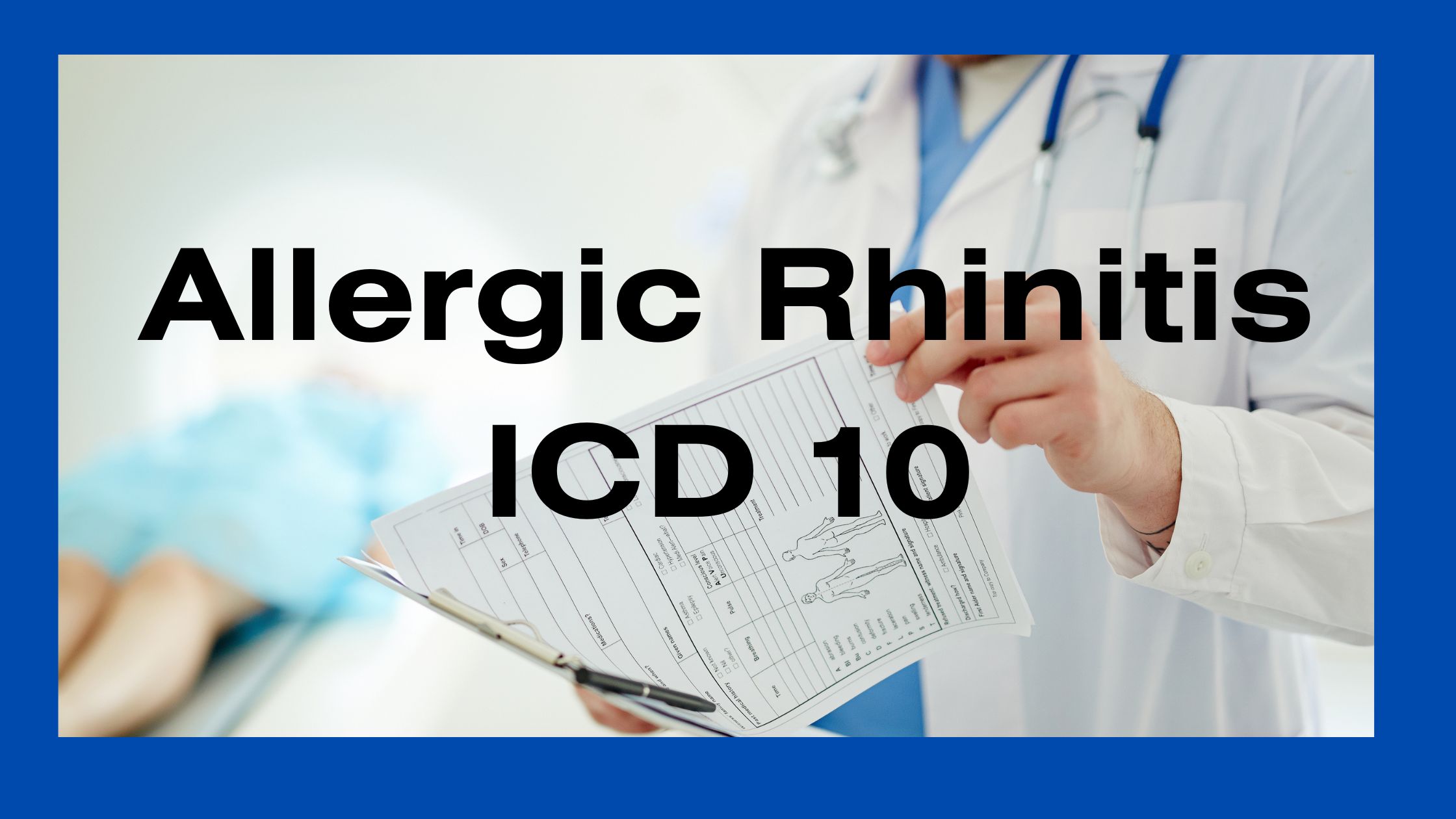Allergic rhinitis is a medical condition that affects a significant percentage of the population worldwide. It is identify as by inflammation of the nasal passages. This condition can cause discomfort and interfere with daily activities. In medical coding, allergic rhinitis ICD 10 code J30.9 is identified by the WHO . This code is used to classify and track cases of allergic rhinitis in healthcare records and insurance claims. This article provide the details of allergic rhinitis, its symptoms, causes, diagnosis, and management.
Symptoms of Allergic Rhinitis:
Allergic rhinitis can manifest through various symptoms that may vary in severity from person to person. Some of the common symptoms include:
1. Sneezing: Frequent bouts of sneezing are often one of the initial signs of allergic rhinitis. Sneezing is the body’s way of expelling irritants from the nasal passages.
2. Runny or stuffy nose: Nasal congestion or a constant runny nose is another common symptom of allergic rhinitis. This can make breathing difficult and may lead to a loss of sense of smell.
3. Itchy nose, eyes, or throat: Individuals with allergic rhinitis may experience itching in these areas. This itching can be bothersome and can lead to discomfort and irritation.
4. Watery eyes: Excessive tearing or watery eyes can occur due to the inflammation of the nasal passages. This can cause redness and a constant need to wipe away tears.
5. Sinus pressure: Some people may experience discomfort or pressure in the sinuses due to congestion. This can lead to headaches and facial pain.
6. Fatigue: Allergic rhinitis can lead to fatigue and reduced energy levels due to disrupted sleep caused by nasal congestion. Poor quality sleep can affect overall well-being and daily functioning.
Causes and Triggers of Allergic Rhinitis:
An immune system response to specific allergens primarily causes allergic rhinitis. When a person with allergic rhinitis comes into contact with these allergens, their immune system releases chemicals such as histamine, which triggers the symptoms of allergic rhinitis. Common triggers include:
1. Pollen: Pollen from grass, trees, and weeds can trigger allergic rhinitis symptoms, commonly known as hay fever. The wind carries these fine particles and can be inhaled, leading to nasal inflammation.
2. Dust Mites: These tiny organisms thrive in mattresses, pillows, and carpets, triggering symptoms when inhaled. Dust mites feed on dead skin cells, and their waste products can cause allergic reactions.
3. Pet Dander: Animal fur, skin flakes, and saliva can cause allergic rhinitis symptoms in susceptible individuals. Even if you don’t have a pet, pet dander can be carried on clothing and spread indoors.
4. Mold Spores: Mold grows in damp and humid environments, and its spores can trigger allergic reactions when inhaled. Common sources of mold include bathrooms, basements, and areas with water damage.
5. Certain Foods: Some individuals may experience allergic rhinitis symptoms due to certain food allergens, such as peanuts or shellfish. This is known as oral allergy syndrome, where proteins in the food cross-react with pollen allergens.
Diagnosis of Allergic Rhinitis:
To diagnose allergic rhinitis, healthcare professionals consider a combination of medical history, physical examination, and specific allergy tests. These tests may include:
1. Skin Prick Test: The skin prick test involves applying small amounts of allergens to the skin with a tiny needle. A small raised bump, known as a wheel, will appear at the test site if a person is allergic to a particular allergen. This indicates an allergy to the specific allergen.
2. Blood Tests: Blood tests, such as the IgE antibody test, can measure the amount of specific antibodies in the blood. This can help identify allergens that may be causing allergic rhinitis symptoms.
3. Nasal Endoscopy: A nasal endoscopy involves inserting a thin, flexible tube with a light and camera into the nasal passages to examine the nasal cavity and sinuses. This can help identify any structural abnormalities or signs of inflammation.
ICD-10 Code J30.9 for Allergic Rhinitis:
The ICD-10 code J30.9 is used to classify cases of allergic rhinitis. This code specifically refers to Allergic rhinitis, unspecified. It is important to note that this code is for medical coding and billing purposes and does not provide detailed information about the severity or specific allergen causing the condition. Healthcare providers use this code to track and document cases of allergic rhinitis for accurate medical records and insurance claims. Other ICD 10 codes are as under,
- J30.9 – Allergic Rhinitis, Unspecified: This code is used when the diagnosis is allergic rhinitis, but the specific cause or allergen is not further specified.
- J21.9 – Acute Bronchiolitis, Unspecified: This code is used to indicate a diagnosis of acute bronchiolitis, which is an infection that primarily affects the bronchioles (small airways) of the lungs. The term “unspecified” means that the specific cause of the bronchiolitis is not further detailed by this code.
- J22 – Unspecified Acute Lower Respiratory Infection: This code is applied when a patient has an acute infection affecting the lower respiratory tract, which includes structures like the bronchi and lungs. The term “unspecified” indicates that the specific cause or type of infection is not further specified.
- J30 – Vasomotor and Allergic Rhinitis: This code category covers conditions related to inflammation of the nasal passages. Vasomotor rhinitis is a non-allergic condition characterized by nasal congestion and discharge. Allergic rhinitis, on the other hand, is an allergic response to substances like pollen, animal dander, and more.
- J30.0 – Vasomotor Rhinitis: This specific code represents vasomotor rhinitis, a condition where the nasal passages become inflamed and congested due to non-allergic triggers like changes in temperature, humidity, or emotional factors.
- J30.1 – Allergic Rhinitis Due to Pollen: This code refers to allergic rhinitis caused by exposure to pollen from plants. It results in symptoms like sneezing, runny or itchy nose, and congestion.
- J30.2 – Other Seasonal Allergic Rhinitis: This code includes cases of allergic rhinitis triggered by specific seasonal allergens other than pollen, such as mold spores or other environmental factors.
- J30.5 – Allergic Rhinitis Due to Food: This code indicates allergic rhinitis caused by specific food allergens. While food allergies typically manifest in gastrointestinal symptoms, they can also trigger nasal symptoms.
- J30.81 – Allergic Rhinitis Due to Animal (Cat) (Dog) Hair and Dander: This specific code pertains to allergic rhinitis triggered by exposure to animal hair and dander, commonly from cats and dogs.
- J30.89 – Other Allergic Rhinitis: This code covers cases of allergic rhinitis caused by allergens not included in the previous categories, such as dust mites or insect allergens.
- J31 – Chronic Rhinitis, Nasopharyngitis, and Pharyngitis: This code category includes chronic inflammations of the nasal passages, nasopharynx, and pharynx.
- J31.0 – Chronic Rhinitis: This code is applied to cases of chronic inflammation of the nasal passages, resulting in symptoms like nasal congestion, discharge, and sneezing.
- J31.1 – Chronic Nasopharyngitis: This code refers to chronic inflammation of the nasopharynx, which is the upper part of the throat that lies behind the nose.
- J31.2 – Chronic Pharyngitis: This code covers cases of chronic inflammation of the pharynx, the area at the back of the throat.
- J32 – Chronic Sinusitis: This code category relates to chronic inflammation of the sinuses, which are air-filled cavities within the facial bones.
- J32.0 – Chronic Maxillary Sinusitis: This code specifically indicates chronic inflammation of the maxillary sinus, which is located in the cheek area.
- J32.1 – Chronic Frontal Sinusitis: This code represents chronic inflammation of the frontal sinus, located in the forehead area.
- J32.2 – Chronic Ethmoidal Sinusitis: This code pertains to chronic inflammation of the ethmoidal sinuses, which are located between the eyes.
- J32.3 – Chronic Sphenoidal Sinusitis: This code is used for chronic inflammation of the sphenoidal sinus, situated behind the ethmoidal sinuses.
- J32.4 – Chronic Pansinusitis: This code indicates chronic inflammation that affects multiple sinuses simultaneously.
Management and Treatment:
Managing allergic rhinitis involves a combination of allergen avoidance, medication, and immunotherapy. Some common management strategies include:
1. Allergen Avoidance: Identifying and avoiding triggers can help reduce the frequency and severity of symptoms. This may involve keeping windows closed during pollen seasons, using dust mite covers on bedding, or minimizing exposure to pet dander. Maintaining good indoor air quality by regularly cleaning and vacuuming the living environment is also important.
2. Medications: Over-the-counter or prescription medications can relieve symptoms. These may include antihistamines, decongestants, nasal sprays, or eye drops. Antihistamines work by blocking the effects of histamine, reducing symptoms such as sneezing and itching. Decongestants help shrink swollen nasal tissues, relieving congestion. Nasal sprays can provide immediate relief by reducing inflammation in the nasal passages.
3. Immunotherapy: Immunotherapy, such as allergy shots or tablets, can be recommended for individuals with severe or persistent symptoms. These treatments aim to desensitize the immune system to specific allergens over time. Allergy shots involve receiving regular injections of small amounts of allergens, gradually increasing the dosage. Allergy tablets are taken under the tongue and can help reduce sensitivity to allergens.
Prevention:
While it may not be possible to prevent allergic rhinitis completely, there are measures to reduce the risk and severity of symptoms. Some preventive strategies include:
1. Keeping indoor areas clean and free from dust, mold, and pet dander. Regular cleaning, vacuuming, and dusting can help minimize allergen exposure.
2. Using high-efficiency particulate air (HEPA) filters in air conditioning units or vacuums to reduce allergen exposure. HEPA filters can trap small particles, including allergens, and improve indoor air quality.
3. Limiting outdoor activities during high pollen seasons or wearing sunglasses to protect the eyes from allergens. Checking pollen forecasts can help individuals plan outdoor activities accordingly.
Conclusion:
Allergic rhinitis is a common condition that affects many individuals worldwide. The ICD-10 code J30.9 is used to classify and track cases of allergic rhinitis in medical records. It is important to seek medical attention to diagnose and manage symptoms properly. By understanding the causes, symptoms, and available treatment options, individuals with allergic rhinitis can effectively manage their condition and improve their quality of life. With allergen avoidance, appropriate medications, and immunotherapy, individuals can minimize the impact of allergic rhinitis on their daily lives and experience relief from bothersome symptoms. Consulting with a healthcare professional is crucial to develop a personalized treatment plan and achieve optimal symptom control.
FAQ
Ans. Common symptoms of allergic rhinitis include frequent sneezing, a runny or stuffy nose, itching in the nose, eyes, or throat, watery eyes, sinus pressure, and fatigue.
Ans. An immune system response to specific allergens primarily causes allergic rhinitis. Common triggers include pollen, dust mites, pet dander, mold spores, and certain food allergens.
Ans. Allergic rhinitis can be diagnosed through medical history, physical examination, and specific allergy tests such as skin prick tests, blood tests, and nasal endoscopy.
Related Articles:
Gram Negative Sepsis ICD-10 A41.50
ICD 10 Asthma Exacerbation J45
Trigger Finger Injection CPT code


